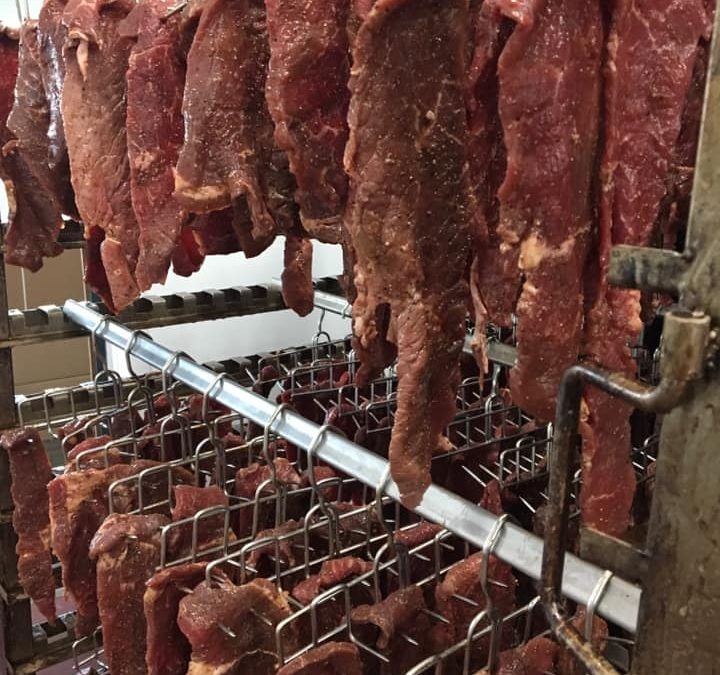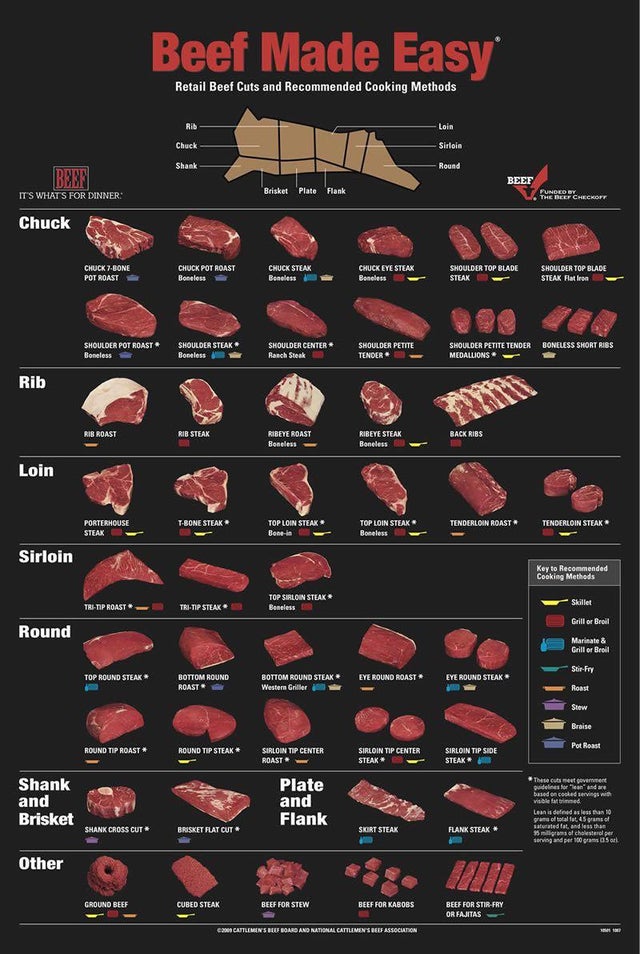Your Guide to Beef Cuts
After a beef animal is slaughtered, the carcass is divided into nine sections of meat known as primal cuts. Primal cuts are the chuck, rib, loin, sirloin, round, brisket, plate, flank, and shank. Each of those categories can be divided into the cut you would like to cook. Depending on your preference of preparing food, will determine which cuts you will choose.
This image is property of cattlemen’s beef board and national cattlemen’s beef association
Chuck
The chuck is a huge primal cut starting from where the head and neck ends, extending to the start of the ribs. This includes shoulder muscles and some of the arms. This part of the body gets a lot of exercise, making the meat tough (and a tendency to get chewy), but it’s also one of the most flavorful cuts, and can be braised, pan broiled, roasted, or grilled.
This cut includes:
Chuck roast ——– Also known as (Blade or 7 bone)
Chuck steaks———- Also known as (Flat iron, Denver (Dakota), and Delmonico
eef. While these are just small cuts, you can get a variety of retail cuts that can be grilled or pan broiled.
The retail cuts from this part are the porterhouse, T-bone, and strip steak, the strip filet and petite roast, the tenderloin roast, and the filet mignon.
The Pot Roast has no other cut options.
You will have an option to decide between the Chuck Arm Roast or the Chuck Steak.
Ribs
As the name implies, this cut comes from the rib area of the animal, which is fairly stagnant throughout the animal’s life, making the meat tender and infused with delicate flavors that come together nicely when grilled, roasted, or pan broiled.
This cut includes:
Rib Steak (Ribeye)
Rib Roast (Prime Rib)
Brisket
This cut comes from the breast area of the cattle, making the meat thick and fatty. It also comes off as tough, but can easily be tenderized when cooked for a long period of time over low heat by braising or roasting, which gives the meat wonderful flavors.
You can get the brisket whole or cut in half.
Plate
The beef plate is a relatively small cut from the opposite side of the ribs. This cut is made of coarse grained meat, which is fatty, and has lots of cartilage and connective tissue. It is a great addition to the ground beef.
Sirloin
This is a large primal cut of tough, flavorful meat. We simply make this cut into steaks and you just need to tell us the thickness you would prefer.
Loin (short and tender)
The loin is composed of the short loin and the tenderloin, the two most popular and most tender sub primal cuts of beef. When you leave the two pieces together with the bone in the middle, that is how you get the T-Bone steak. If you cut the bone off of the meat, the larger piece of meat is the Strip Steak and the smaller piece becomes the Tenderloin.
Round
The round is the back end of the animal. It is divided into the top round and the bottom round. You have an option to have the top round tenderized before it is packaged. The meat can be tough but lean, which are best cut thinly, and can be roasted, grilled, or pan broiled.
This cut is composed of:
Top round: round steak or tenderized round steak
Bottom round: round roast, round steak, or ground beef
The Bottom Round is a very lean piece of meat. If you are interested in leaner ground beef, grinding the bottom round would be a good choice.
Flank (Skirt) and Shank
The Flank and the Shank come from the underbelly and legs. These are both filled with tough muscle fibers and connective tissue, and are best when marinated or made into ground beef. They can also be grilled, roasted, pan broiled, or braised. The Shank can be for oso bucco or soup bones. The Flank is good for fajita meat, philly steak, and finger steaks.



Keep in mind that the same cuts of beef can have different names. For example, a boneless top loin steak may also be called a strip steak, club sirloin steak or N.Y. strip steak.